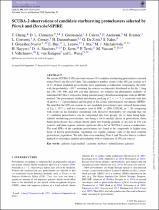| dc.identifier.citation | T Cheng, D L Clements, J Greenslade, J Cairns, P Andreani, M Bremer, L Conversi, A Cooray, H Dannerbauer, G De Zotti, S Eales, J González-Nuevo, E Ibar, L Leeuw, J Ma, M J Michałowski, H Nayyeri, D A Riechers, D Scott, P Temi, M Vaccari, I Valtchanov, E van Kampen, L Wang, SCUBA-2 observations of candidate starbursting protoclusters selected by Planck and Herschel-SPIRE, Monthly Notices of the Royal Astronomical Society, Volume 490, Issue 3, December 2019, Pages 3840–3859, https://doi.org/10.1093/mnras/stz2640 | en_US |
| dc.description.abstract | We present SCUBA-2 850 μm observations of 13 candidate starbursting protoclusters selected using Planck and Herschel data. The cumulative number counts of the 850 μm sources in 9 of 13 of these candidate protoclusters show significant overdensities compared to the field, with the probability <10−2 assuming the sources are randomly distributed in the sky. Using the 250, 350, 500, and 850 μm flux densities, we estimate the photometric redshifts of individual SCUBA-2 sources by fitting spectral energy distribution templates with an MCMC method. The photometric redshift distribution, peaking at 2 < z < 3, is consistent with that of known z > 2 protoclusters and the peak of the cosmic star formation rate density (SFRD). We find that the 850 μm sources in our candidate protoclusters have infrared luminosities of LIR≳1012L⊙ and star formation rates of SFR = (500–1500) M⊙ yr−1. By comparing with results in the literature considering only Herschel photometry, we conclude that our 13 candidate protoclusters can be categorized into four groups: six of them being high-redshift starbursting protoclusters, one being a lower redshift cluster or protocluster, three being protoclusters that contain lensed dusty star-forming galaxies or are rich in 850 μm sources, and three regions without significant Herschel or SCUBA-2 source overdensities. The total SFRs of the candidate protoclusters are found to be comparable or higher than those of known protoclusters, suggesting our sample contains some of the most extreme protocluster population. We infer that cross-matching Planck and Herschel data is a robust method for selecting candidate protoclusters with overdensities of 850 μm sources. | en_US |

